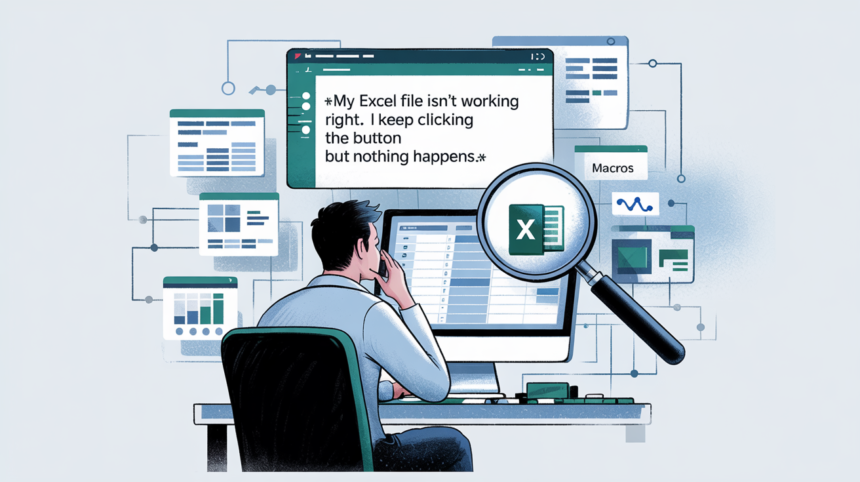**”My Excel file isn’t working right. I keep clicking the button but nothing happens.”
If that sounds familiar, you’re not alone.**
This is a super common frustration for anyone working with Excel templates, dashboards, or automation files. Most times? It all comes down to one thing: macros aren’t enabled.
And without macros, Excel can’t run the code behind buttons, automations, or even basic form actions.
So, in this guide, we’re going to cut through the confusion and walk you step-by-step through how to enable macros in Excel. Whether you’re on Windows or Mac, using Excel 365 or an older version, or even worried about macro viruses, I’ve got you.
Let’s break it down in a simple, no-jargon way with screenshots, tips, common mistakes, and even a few behind-the-scenes pro tricks to make your Excel life easier. Think of this as your macro survival guide.
Why Are Macros Even a Thing in Excel?
Before we get into the how-to part, let’s talk about why this matters.
Macros are tiny programs written in VBA (Visual Basic for Applications). They automate repetitive tasks in Excel. Think:
- One-click report generation
- Auto-sorting your data
- Pop-up alerts when values are out of range
- Forms that act like apps inside Excel
- Batch editing cells and formatting instantly
- Pulling real-time data from other files or sources
Basically, macros turn Excel from a spreadsheet tool into a lightweight app platform.
But Microsoft locks them down by default for security. Why?
Because macros can also be used to hide malicious code. There have been real-world cyberattacks where fake resumes, invoices, or reports had hidden macros that stole data or installed malware. According to Microsoft’s official security guidance on macros, they now block macros in files from the internet by default to reduce risks.. There have been real-world cyberattacks where fake resumes, invoices, or reports had hidden macros that stole data or installed malware. So unless you manually enable them, Excel keeps them off to protect your data and your system.
That’s why knowing how to enable macros in Excel the right way matters.
First: What Excel Version Are You Using?
The steps to enable macros vary slightly based on your version:
| Excel Version | Macros Enabled By Default? | Special Notes |
|---|---|---|
| Excel 365 (Windows) | No | Uses “Protected View” for internet files |
| Excel 2021/2019/2016 | No | Very similar steps to Excel 365 |
| Excel for Mac | No | Settings are in a different location |
| Excel Online | No | Macros don’t work at all |
Make sure you know which version you’re using so you follow the right steps. If you’re not sure, go to File > Account in Excel and check your product info.
How to Enable Macros in Excel (Windows)
Here’s your main walkthrough. Let’s keep it super actionable.
1. Enable Macros When You Open a File
When you open a macro-enabled file (.xlsm), you might see a yellow warning bar:
“Security Warning: Macros have been disabled.”
Here’s what to do:
- Click “Enable Content” right in the warning bar.
- That’s it. Macros will now run as intended.
But if you don’t see this bar or it doesn’t show up consistently, don’t worry we’ll troubleshoot that below.
2. Enable Macros in Excel Settings (Always On)
If you work with macros often, it gets annoying to click “Enable” every time.
To always allow macros:
- Open Excel
- Go to File > Options > Trust Center
- Click “Trust Center Settings…”
- Choose “Macro Settings” on the left
- Select:
- “Enable all macros” (not recommended for security)
- OR: “Disable all macros with notification” (safe middle ground)
- Hit OK and restart Excel
Note: The best practice is to only enable macros from sources you trust. If you’re working in a corporate environment, your IT department might have group policies that override these settings.
How to Enable Macros in Excel (Mac)
Excel for Mac hides these settings in a different spot.
Here’s what you do:
- Open Excel on your Mac
- Click Excel > Preferences (top-left)
- Go to Security
- Look for “Enable all macros” or “Disable all macros with notification”
- Choose based on your comfort level
- Close preferences and reopen your workbook
Just like on Windows, you’ll often see a yellow bar asking if you want to enable content. Click it to allow macros. If you don’t see the bar, you might need to adjust privacy and permissions in macOS system settings too.
Bonus: Macros on Excel for iPad or iPhone?
Bad news: Macros don’t work in mobile Excel apps. If you open a macro-enabled workbook, the features won’t run.
What If There Is No Enable Option? (Common Problem)
Sometimes, the yellow bar never shows up. You click buttons, nothing works.
Here’s what might be happening:
A. File is in Protected View
If your Excel file came from email or the web, it’s probably opened in Protected View.
To fix:
- Click File > Info
- Look for a yellow box that says “Protected View”
- Click “Enable Editing”
- Then, click “Enable Content” to turn on macros
B. File Type Isn’t Macro-Compatible
Check your file extension:
- If it ends in .xlsx that’s not a macro file! It can’t hold macros at all
- Save it as .xlsm instead:
- File > Save As > Choose .xlsm (Macro-Enabled Workbook)
This is probably the most overlooked step. If your file isn’t in the right format, macros simply won’t exist inside it.
C. Your Trust Center Is Blocking It
Sometimes, Excel blocks macros based on location.
You can fix that by adding the folder to your Trusted Locations:
- File > Options > Trust Center > Trust Center Settings
- Click Trusted Locations
- Add the folder where your macro files live
Trusted folders bypass some of the macro warnings altogether. It’s a power user move and saves you tons of clicks.
D. Digital Signature Issues
If a macro is digitally signed but the certificate isn’t trusted on your machine, Excel will block it. This is more common in corporate or government systems.
Fixing it usually means installing the certificate via your browser or IT administrator.
Quick Macro Enabling Checklist
Here’s a fast list to go through if macros aren’t working:
Go down this list, and 90% of macro issues vanish.
User Question: Is It Safe to Enable Macros in Excel?
Short answer: depends who sent you the file.
Macros are powerful they can delete files, send emails, or modify your system. If a hacker hides a malicious macro in a spreadsheet, opening it could compromise your PC.
So only enable macros if:
- You made the file
- You trust the person who did
- You scanned the file with antivirus
- The sender is a known contact or company
Avoid enabling macros from unknown emails or downloads. As NIST (National Institute of Standards and Technology) outlines in their cybersecurity guidelines, macros remain a common vector for phishing attacks. Even better? Open it in Google Sheets or Excel Online first those platforms don’t run macros at all.
And if you’re working in finance, HR, or procurement? Be extra cautious. Those teams are often targeted with fake macro-based attacks.
Pro Tips from a Real Excel Nerd
Alright, if you use macros a lot, here are a few real-world insights:
- Sign your macros with a digital certificate (makes Excel trust your files faster)
- Use the “Personal Macro Workbook” to store macros you want in every file
- Add a custom button on your toolbar to run your favorite macro
- Name your macros something readable (not Module1.Macro1)
- Use
Application.ScreenUpdating = Falsein your code to speed things up
Also, if you ever build macro tools for others:
- Add a friendly popup if macros are disabled (use
MsgBoxin VBA to guide them) - Include a ReadMe tab with macro instructions
- Use clear naming for buttons like “Run Report” or “Import Data”
- Add error handling with
On Error Resume Nextand message feedback
Bonus tip: Keep backups. Macros are powerful but can go haywire with one bad line of code.
Summary: Macros Are Easy to Enable (Once You Know How)
Macros make Excel way more powerful. But they’re locked down to keep you safe.
Now that you know how to enable macros in Excel, here’s what to remember:
- Use .xlsm format
- Enable macros only from trusted sources
- Use Trust Center settings if you work with macros a lot
- Add trusted folders to avoid repeated prompts
- Be aware of security risks and digital signatures
With a few tweaks, Excel becomes your personal automation machine. Want to dive deeper into safe macro usage? Excel Easy’s VBA Macro Guide has a great beginner-friendly overview of creating and running macros. You’ll save time, reduce errors, and work smarter not harder.
Go ahead, try enabling macros now and see how much faster your spreadsheets can be.






